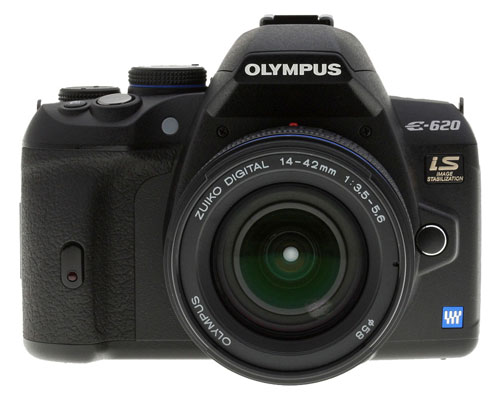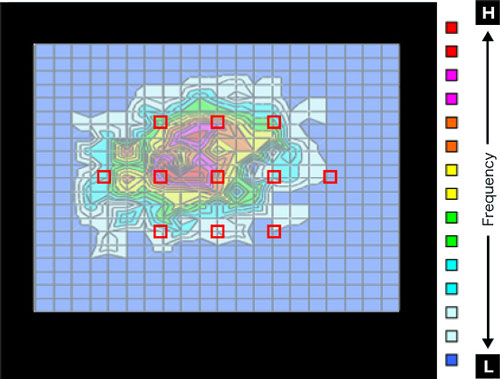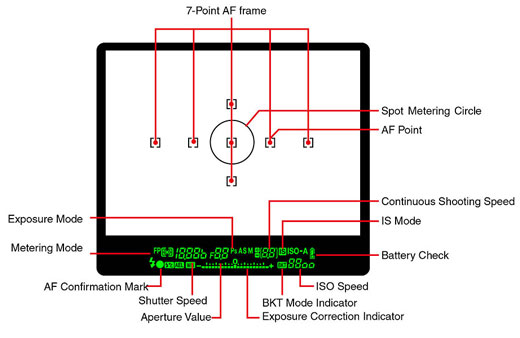PMA 2009: Panasonic GH1 & Olympus E620
by Wesley Fink on March 9, 2009 5:40 PM EST- Posted in
- Digital Camera
Olympus E-620
In our look at the flag-ship Olympus E-3 in late 2007, the AF performance was a dramatic improvement over anything previously from Olympus. The new module featured 11 double cross-point sensors and claimed the fastest AF on the market with the new SSW lenses.
The fast E-3 11-point AF was quite a step-up from the Olympus 3-point AF. As mentioned in that review, it was our opinion Olympus needed to migrate that AF module down to mid and entry models as soon as possible.
The first example of this migration was the 12.3 Megapixel E-30, which is now in the lab at AT for review. The E-30 is all but the same AF as the E-3, but with claimed improvements which make the AF even speedier. That makes the E-30 AF a joy to work with, but it really doesn’t bring the new AF module to a new price point in the Olympus line.
The E-30 is designed for the upper Prosumer or Advanced Amateur market with a MSRP of $1299. It’s actual selling price today still remains around that $1299. The problem is that is almost exactly the same street price as the pro-oriented E-3 is actually selling for today. That means the new Olympus AF module is just as innovative and desirable as before, but it is still selling for a premium in the Olympus DSLR line.

The introduction of the E-620 is exciting because for the first time it moves much of the technology of the Olympus E-3 AF module to an Olympus entry DSLR model. The E-620 module is based on the same research that went into the E-30/E-3 and it is the same basic point pattern.

As you can see in the above diagram from Olympus, the E-30/E-3 AF module places the 11 double cross points where research indicates they are most needed.

In the E-620 viewfinder, you can see the four corner points have been eliminated – reducing AF points from 11 to 7. That is certainly understandable in reducing cost for the move of the AF module to an entry DSLR. However, in a very un-entry move, the 5 center AF points are all double-cross – sensitive to both horizontal and vertical. The entry competition has at best one center cross-point, so the E-620 should be quite the AF competitor in the entry DSLR market.
Those who know Olympus DSLR cameras will also notice Olympus moved the viewfinder info from the right of the VF to below. Olympus also claims the viewfinder is larger and easier to see on the new E-620.

A very pleasant surprise on the E-620 is the swing and tilt 2.7” LCD inherited from the E-30/E-3.Once you have used the articulating LCD for self-portraits, self-timer images, high/low angle shooting, or Live View shooting you will fully appreciate its usefulness. Many will be very happy this feature is now available on an entry E-620 model that combines it with the superb Panasonic 12.3 Megapixel Live MOS sensor and multi-point contrast-detect Live View focusing.
The E-620 is slated to ship in April at a MSRP of $699 for the body alone or $799 for the body with the 14-42mm kit lens. Looking at any entry competitors in today’s market the E-620 stands out as a superb value with useful, unique features. Olympus even introduced an accessory battery grip for the E-620, a first for an Olympus entry DSLR. Those who value small size in cameras, a tilt-and swivel LCD, fast AF, and enhanced creative control should definitely take a look at the new E-620.










12 Comments
View All Comments
Flyboy27 - Tuesday, March 10, 2009 - link
Are there any lenses for micro 4/3 cameras besides the kit lenses. I can't find anything. All I see are regular 4/3 lenses. Are they compatible?Wesley Fink - Thursday, March 12, 2009 - link
Panasonic also announced the LUMIX G VARIO 7-14mm/F4.0 ASPH lens introduction at PMA 2009. That brings the micro four-thirds lenses to four so far. The 7-14mm is equivalent to a 14-28mm lens on a 35mm.Wesley Fink - Tuesday, March 10, 2009 - link
You might want to refer back to the Panasonic G1 launch article at http://www.anandtech.com/digitalcameras/showdoc.as...">http://www.anandtech.com/digitalcameras/showdoc.as... where we discuss the technology, accessories, and roadmap in more detail.Wesley Fink - Tuesday, March 10, 2009 - link
There are currently 3 Micro four-thirds lenses and all three have optical imaging stabilization with Mega O.I.S. In addition to the 14-140mm HD kit lens for the GH1, there is the $349 MSRP 45-200mm OIS and the G1 kit lens 14-45 OIS. Many more Micro 4/3 lenses are planned.Four-thirds lenses from Olympus, Leica, Panasonic and Sigma will work on the micro four-thirds mount with an adapter. Some fully support contrast detect AF and some do not. You can see a complete list of 4/3 lenses at Olympus. The Panasonic DMW-MA1 micro 4/3 adapter is available for around $169 at Amazon and other vendors. I have seen it advertised as low as $104.
One of the lenses that works perfectly with the adapter on micro 4/3 is the Leica 25mm f/1.4. I also have used the micro 4/3 mount 45-200mm, which is equivalent to a 90-400mm 35mm lens and it is very good quality with useful image stabilization.
A new adapter for micro 4/3 was just introduced for Leica M lenses. There are also adapters that will allow you to mount many other lenses like Canon, Nikon, Pentax, etc. on the micro 4/3 but they will be manual focus on the G1 and GH1.
extra - Friday, March 13, 2009 - link
"Some fully support contrast detect AF and some do not."Yeah, most of them don't. However, the good news is this: Panasonic is on the ball here. With how on top of things they have been with their camera line up, they are clearly very focused on their imaging division at the corporate level.
What this means is that you can pretty much count on there being a full lineup of great lenses from them. It's not going away. I wouldn't worry about the lenses that may be available in the future as long as you can live with what they've got now. Also, their lenses are optically quite good, even the kit ones~!
SuperflyDK - Tuesday, March 10, 2009 - link
Quote: "However, in a very un-entry move, the 5 center AF points are all double-cross – sensitive to both horizontal and vertical. The entry competition has at best one center cross-point..."The Canon competition has this as well, so now there are 2 manufactures with 7 (or Canon 9) crosssensitive autofocus points in the upper prosumersegment.
Both the Canon EOS 40D and the 50D has a 9 point crosssensitive AF.
Cool regards,
Superfly
Wesley Fink - Tuesday, March 10, 2009 - link
The E-620 is entry, not upper prosumer, and nothing from Canon or Nikon in the entry area (XSi, XS, D60) has multiple AF cross-points that I am aware of. The XSi/XS has 9/7 AF points with only the center as double-cross. The D60 has 3 points and I don't think any of them are cross-point though the center one may be.The E-620 competes at entry and it is not really fair to compare it to mid-range Canon's like the 40D/50D. The Olympus E-30 competes in that market, and it has 11 AF cross-points in two planes (44 total AF points).
extra - Friday, March 13, 2009 - link
Correct. *HOWEVER* there is a lot more to auto focus than simply being able to detect contrast in multiple directions. Having those multiple cross-type sensors doesn't automatically mean that the af on this thing is going to be better than canon or nikon af. Also remember that 4/3 is a much smaller sensor than aps-c. So I wouldn't get too excited about this thing yet, reserve judgment until more people have gotten to play with it.teldar - Sunday, March 15, 2009 - link
I believe he was replying to the inaccurate statement made by a previous poster. And since HE would be the person reviewing the camera for DT (he he is able to get a review sample) he would probably be the one who is most knowledgable and reliable about its performance if/when it's reviewed.finbarqs - Tuesday, March 10, 2009 - link
From panasonic's anouncement, they said that the camera will deliver full 1920x1080p video @ 24fps with full exposure controls